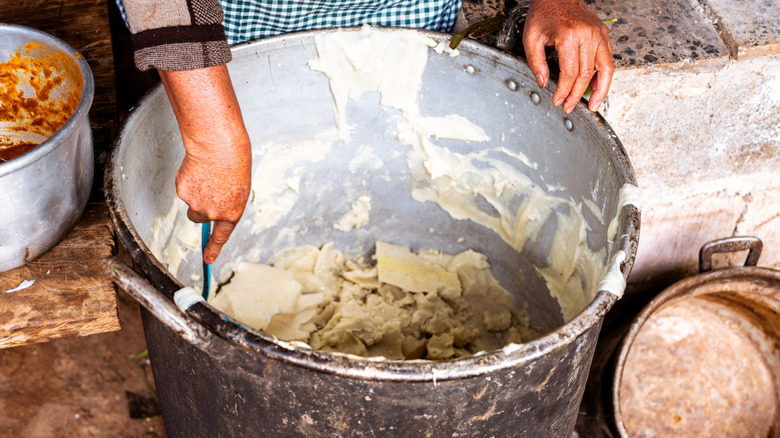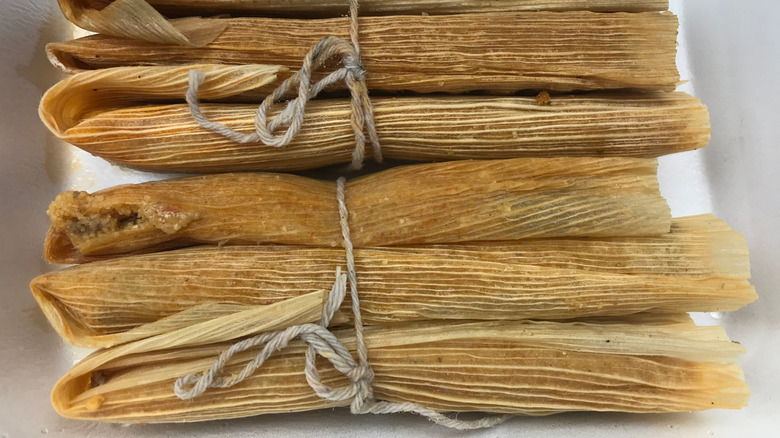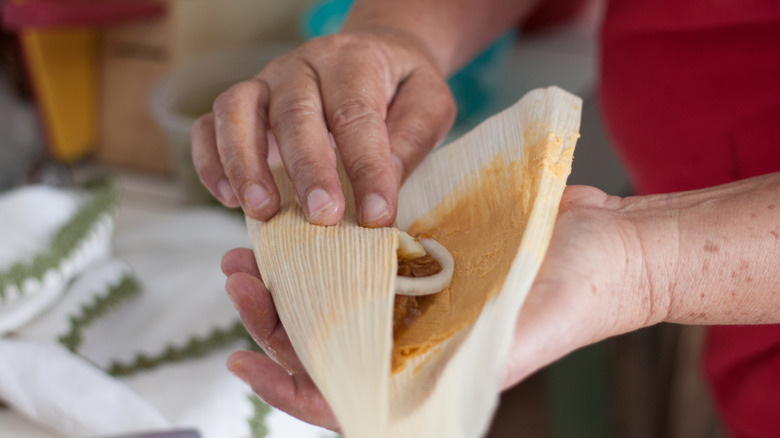14 Mistakes Chefs Say You Should Avoid When Making Tamales At Home
Tamales have a reputation for being difficult to make. However, it's not necessarily that they're technically hard to whip up, it's just that they can go awry in various ways. There are mistakes everyone makes with homemade tamales when they're not well-versed in them, but luckily they're easily avoided once you know what to do and what to avoid.
The trouble is that some of these are small nuances that are easily overlooked by the inexperienced. That's why we spoke to two tamale experts who have been making these delicious treats since they were kids. We interviewed two trained chefs and food industry professionals who were kind enough to share their secrets.
Whether you have a favorite recipe for tamales that you're looking to perfect or you're totally new to making them, it's a great idea to troubleshoot ahead of time. These are some of the most common errors people make when cooking tamales and how you can fix or avoid them. So, next time you whip up a batch, they'll be better than ever.
1. Adding too little fat to the masa
The dough that makes up the exterior of tamales is known as masa. This shouldn't be confused with masa harina, which is a kind of corn flour often used in tamales (as well as corn tortillas and more). When making masa, one common mistake is adding too little fat. It might seem innocuous, but it can lead to various problems.
Lard is common in Mexican cooking and is the fat most often used for tamales. However, if you don't have lard, you can use vegetable shortening. This gives you the most similar results, but is suitable for vegetarians and vegans, so it's the perfect thing to use if you're cooking for people who don't eat meat. Ellen Marie Bennett is a trained chef and founder of chef gear company Hedley & Bennett, who grew up making tamales with her abuelita. She suggests using butter in place of lard in sweet tamales.
But whatever fat you use, it's important to use enough of it. According to Lucia Gomez, sous chef of Mezcal at Montage Los Cabos, too little fat in the masa can cause tamales to stick to the husks they're cooked in when you try to unwrap them. "A proper masa will cook and the fats will create a covering layer between the husk and the masa, avoiding any masa from sticking," she explains. Plus, Bennett tells us that with too little fat, you won't get a tender, melt-in-the-mouth texture.
2. Not whipping the fat
It's not just how much fat you use when making tamales but what you do with it. Whipping the fat for the masa is a step that many people overlook. When faced with a lengthy recipe, you might think it's just an extra, unnecessary step that takes up more time, but it's there for a reason.
"You will want to whip the fat until it's almost the consistency of a cake frosting before mixing in your masa," Ellen Marie Bennett tells us. But why? Beating the fat incorporates air into it, resulting in a lighter masa. This, in turn, gives you tamales that are fluffier and spongier. It's a simple step but it can make all the difference.
To get the fat to the correct consistency, you should beat it in a stand mixer on a medium speed for around four minutes or slightly longer using an electric hand mixer. It isn't a good idea to try this by hand, as it will take too much elbow grease. At this point, you can add the dry ingredients, like masa harina flour and baking powder.
3. Overmixing or undermixing the masa
According to Ellen Marie Bennett, both undermixing and overmixing masa are common mistakes. It's hard to overmix if you're kneading the masa by hand, but it's much more possible when using a stand mixer. Both mixing too much and not mixing enough can cause problems, so it's important to get it just right.
It takes about five minutes to knead masa in a hand mixer, eight to 10 minutes with an electric hand mixer, or 15 to 20 minutes by hand. The resulting dough is a bit like a thick, airy, spreadable cake batter. It's much thicker than something like pancake batter, but less firm than bread dough or pastry dough.
Undermixing it is more of a problem than overmixing it. When it's undermixed, the masa won't have enough air whipped into it and it will end up dense. However, if you mix it for way too long, you could end up knocking the air out of it and have the same problem. It's also just unnecessary and wastes time.
4. Making the masa too dry
Not properly hydrating the masa by adding too little water or broth is a common error people make with homemade tamales. This ultimately leads to dry, crumbly tamales. You won't realize until you've finished steaming them, though, which can be devastating.
"A dry tamale is never pleasant to eat, so under hydrating the masa is a crucial mistake," remarks chef Lucia Gomez. "This is common since it is harder to work with a well hydrated masa," she adds. So, follow the recipe and don't think you know better about how much liquid to add.
Generally, recipes call for slowly adding a quantity of water or broth to the masa while mixing it. At a certain point, you might think that you've added enough and the dough is ready to knead but it's important you use all the liquid in the recipe. A well-hydrated dough leads to moist, fluffy tamales, which is what you want. When it's properly hydrated, masa can be sticky, but this doesn't mean that it's too wet.
5. Underseasoning the masa
Many people see the masa as inconsequential compared to the filling but this isn't the case. It also adds lots of flavor to tamales and is a big part of their appeal. So, you should avoid the mistake of underseasoning the masa or otherwise neglecting its flavor.
Lucia Gomez of Mezcal talks about the importance of adding salt to the masa, noting that it's not just the filling that brings flavor to the finished tamales. "Masa that's seasoned well will make your tamales sing," says Ellen Marie Bennett of Hedley & Bennett. "Taste as you go and don't be shy with your spices," she adds.
Many recipes also call for broth in the masa, rather than water. This is another way of making it more flavorful. A good homemade stock will give you the absolute best-tasting results, but otherwise a high-quality store-bought option works. Just make sure it's something you like the taste of before using it as a component in your masa.
6. Not realizing there are regional variations
When you're making tamales, you might not realize that there are regional variations. And this can leave you missing out on some excellent options. The ones that many people are familiar with are Mexican tamales, but Delta-style tamales are an option that's often overlooked outside certain parts of the U.S.
So, what's the difference between Delta tamales and Mexican tamales? For starters, let's look at their origins. Mexican tamales are the originals, but when folks from Mexico started emigrating to the U.S. for work, they brought tamales with them. They were influenced by the flavors and ingredients of the American South and changed over time.
One big difference is in the corn used. Mexican tamales use masa harina, while Delta-style tamales use cornmeal. Cornmeal produces crumblier, grainier tamales compared to Mexican versions, but it also has a more intensely corn-like flavor, which many people love. Delta tamales are usually smaller than Mexican ones and served with a sauce. Plus, they're simmered rather than steamed. It's generally hard to find Delta-style tamales outside of the American South.
7. Making masa that doesn't pass the float test
For those not in the know, it can seem tough to tell when you've got your masa just right. This means you might go through the long steaming process only to wind up with disappointing tamales. But luckily, there's an easy way: the float test. If you aren't using this to work out whether your masa is ready to start forming tamales with, you're making life hard for yourself.
But, what is the float test? Basically, it involves tearing off a small piece of masa and dropping it in a glass of water. "If it floats, you're golden — it means your masa is light, airy, and ready to steam," Ellen Marie Bennett explains. "If it sinks, that means it needs a bit more air and fat."
If you're interested in why this happens, chef Lucia Gomez has the answer. She tells us that masa is an emulsion of fat and the rest of its ingredients. You probably already know that oil will always float on the top of a glass of water. Well, "when we do a tamale masa test, it is basically the same," Gomez says. If the masa doesn't float it's letting you know that there's not enough fat in the mixture. And the result? "If we were to cook the dough as it is we will end up with a dry tamale and it could stick to the corn husk or banana leaf it is cooked inside of," remarks Gomez.
8. Not hydrating the corn husks properly
Tamales are cooked individually inside corn husks. This holds the heat and moisture in so they steam properly and also keeps them in shape. But, a common misstep when making tamales is failing to hydrate the corn husks properly.
You need to hydrate the corn husks in order to make them flexible and keep them from cracking. Otherwise, your tamales will dry out during cooking. Ellen Marie Bennett recommends soaking the husks in hot water for around 30 minutes before beginning assembly. Lucia Gomez advises separating the husks before soaking because some are thicker than others and need longer to become flexible. Once they seem flexible enough to wrap a tamale in, they're ready to use.
It's worth noting that in Oaxaca and Southern Mexico, people use banana leaves instead of corn husks to wrap tamales. This is simply down to availability — in this region, banana leaves are easier to come by than corn husks. However, they do tend to add a certain sweetness to the tamales. They come fresh or frozen, so you don't need to hydrate them, but some people heat them over a gas flame to make them more pliable and less prone to cracking.
9. Using too much masa
When it's time to assemble your tamales, you spread a layer of masa over the corn husk or banana leaf, add the filling and fold it up into a little package for steaming. It seems simple enough, but many people add too much masa at this stage. Although you need enough to fully encase the fillings, using too much is a problem.
Ellen Marie Bennett tells us that less is more here. You want the correct ratio of masa to filling. Too much masa will leave you with tamales that are basically steamed cornbread without much going on inside. But, at the same time, you don't want the filling to overwhelm the outer layer, either.
You need about 2 tablespoons of masa per tamale, spread thinly over the corn husk, with a border of around 1 inch at the top and sides and 2 inches at the tapered bottom. You can scrape off any excess if the layer ends up too thick, but 2 tablespoons is roughly right to make a 4 inch square. It might not look like much, but tamales puff up as they steam, so you'll get more of the outside layer than you might imagine.
10. Sticking with the same fillings every time
The beauty of tamales is the practically infinite combination of fillings you can stuff them with. You can experiment with so many combinations of flavors and textures. So it's a crying shame if you always stick to the same ones.
But, it's natural you'd need some inspiration. "My ride-or-die favorites?" Ellen Marie Bennett says. "The classics: pork with red chile, chicken with green chile, and sweet ones like pineapple or chocolate mole." Yeah, that's right. You can make sweet dessert tamales as well as savory ones — and we'd highly recommend it. But you can also think beyond the classics. Grilled corn, mango salsa, and fresh herbs; roasted veggies, crispy onions, and chimichurri; or even just a whole load of cheese.
Lucia Gomez says that she thinks about the three main components of her fillings when creating them — the fat, the liquid, and the filling. So, she might make a veggie tamale with her choice of vegetable oil, a vegetable broth, and puréed sweet potato. This helps create a more cohesive filling. But, she also advises getting creative.
11. Wrapping too loosely and failing to get a good seal
You've spread the masa, layered on the filling, and now it's time to fold up the tamale for steaming. Well, this is where a lot of people end up going wrong. It's all too easy to wrap the husk up overly loosely and fail to get a good seal.
"If your tamale isn't snug, it'll fall apart during steaming," says Ellen Marie Bennett. She also talks about the importance of a good seal. Without this, steam will escape and your tamales might not cook evenly. While you'll find countless different ways of folding or wrapping a tamale, the goals are all roughly the same. People just use slightly different methods to do the same thing.
You need to fold one side of the masa over the filling, peel back the husk slightly, fold the other side of the masa to overlap the first, and press down to get a seal. Then, you wrap the husk around the masa, folding the bottom under and leaving the top open. Some people press the top of the masa together, while others leave it to seal when each side expands during steaming. You can also use a strip of corn husk to tie up the husk if you're concerned about it unfolding, but packing them into a steamer usually stops this from happening.
12. Making unevenly sized tamales
It's important to make all the tamales in a batch roughly the same size. This might seem like an undertaking, but it's actually not that difficult. The resulting tamales will be all the better and more consistent for it.
Lucia Gomez admits that assembling tamales is an exercise in patience. However, she says that you should "focus on having a uniform size between your batch since this will help with even cooking throughout." When your tamales are all different sizes, some will take longer to steam than others. If you stop steaming when the smaller ones are done, the larger ones will be underdone. While, waiting until the larger ones are done means the smaller ones will be overcooked.
For average tamales, you'll need around 2 tablespoons of masa and 1 to 2 tablespoons of filling. Stick to this for each one and you'll end up with even sizes across the whole batch.
13. Undercooking or overcooking tamales
Once your tamales are all wrapped in their corn husks, they're ready to steam. But, it's important not to fall at the final hurdle and end up either overcooking or undercooking your tamales. This would be a huge disappointment after putting so much time and effort into getting them right.
According to Ellen Marie Bennett, tamales can be on the temperamental side when it comes to timing. "Overcooked ones get mushy, and undercooked ones are sad, dense little lumps," she says. "The sweet spot is all about steaming until your masa feels firm, pulls away from the husk easily, and is light and tender," she adds.
If you're worried about overcooking your tamales, it's best to start checking toward the lower end of the cooking time specified in your recipe. So, if it calls for 1 to 1 ½ hours of steaming, start checking them at around 55 minutes. When they're ready, the husk should peel away from the dough and the masa will feel firm. You can also cut one open to check that it's firm all the way through, which can be useful if it seems done but you're not totally sure. If they're not ready, check again after 5 to 10 minutes.
14. Running out of water in the steamer
It might seem like an obvious error, but one of the biggest mistakes people make with tamales is running out of water in the steamer. They steam for a fairly long time, so adding too little water is a common occurrence. Doing so not only means your pan will boil dry and might get damaged, but your tamales will end up undercooked because there's no water in the pot to produce steam.
To avoid this, fill the bottom of the steamer up as much as possible. The water level should reach up to the steamer basket, but not over its base. The tamales shouldn't be sitting in any water. This amount of water should last through the full steaming process, but it's a good idea to check the level around halfway through cooking. Lift up the basket and look inside, being careful to avoid getting scalded by steam. Top it up with more hot water, if necessary, so there's enough to complete the rest of the cook time.














